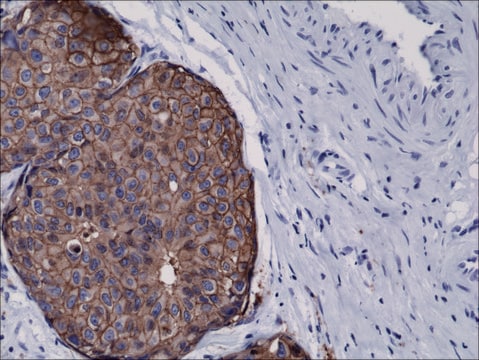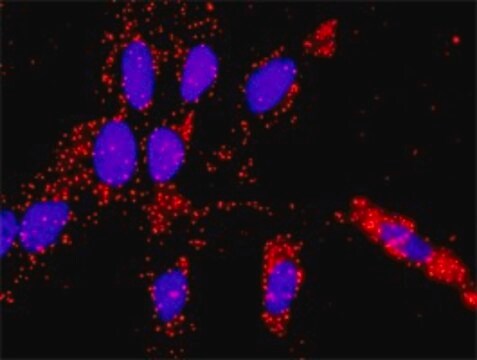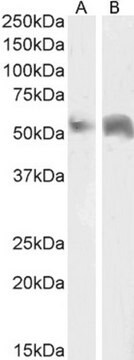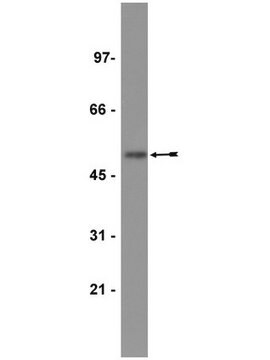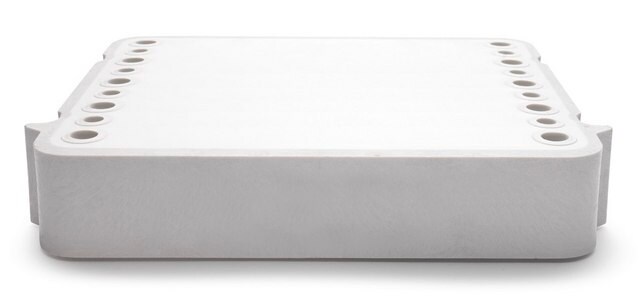MABC983
Anti-CD1d Antibody, clone D5
clone D5, from mouse
Synonym(s):
Antigen-presenting glycoprotein CD1d, R3G1, CD1d
Sign Into View Organizational & Contract Pricing
Select a Size
All Photos(1)
Select a Size
Change View
About This Item
UNSPSC Code:
12352203
eCl@ss:
32160702
NACRES:
NA.41
Recommended Products
General description
Antigen-presenting glycoprotein CD1d (UniProt P15813; also known as CD1d, R3G1) is encoded by the CD1D gene (Gene ID 912) in human. CD1d is an MHC-like glycoprotein expressed on epithelial cells and can signal innate immune responses by presenting lipid antigen to natural killer (NK) and NK T (NKT) cells. Similar to MHC class I heavy chain (HC), CD1d HC is glycosylated and assembled with β2m in ER. Unlike MHC class I HC, misfoled CD1d and CD1d not properly assembled with β2m are not destroyed by ER quality control mechanisms. CD1d plays a role in both innate and adaptive immunity to various bacteria, viruses, fungi, and parasites. Activation of CD1d-restricted invariant NKT cells enhances host resistance to these microbes via direct killing of CD1d-expressing (infected) cells or by promoting interferon gamma release from conventional NK cells and by modulating adaptive immune cells via alteration of Th1/Th2 polarization. Chlamydia trachomatis is shown to prevent CD1d-mediated innate immune destruction of the infected urethral epithelial cells by targeting CD1d for proteolytic degradation. Specifically, the chlamydial proteasome-like activity factor (CPAF) interacts with the CD1d HC, and CPAF-associated CD1d HC is then ubiquitinated for eventual degradation.
Immunogen
Epitope: CD1d α1 domain
Pooled CD1d-GST fusion proteins containing α1 domain alone, α1-α2 domains, or α1–α3 domains.
Application
Research Category
Apoptosis & Cancer
Apoptosis & Cancer
Research Sub Category
Apoptosis - Additional
Apoptosis - Additional
This Anti-CD1d Antibody, clone D5 is validated for use in Western Blotting, Immunoprecipitation for the detection of CD1d.
Western Blotting Analysis: A representative lot detected time-dependent CD1d degradation in CD1d immunoprecipitate from human penile urethral epithelial (PURL) cells following C. trachomatis infection (Kawana, K., et al. (2007). J Biol Chem. 282(10):7368-7375).
Western Blotting Analysis: A representative lot detected exogenously expressed CD1d in CD1d-transfected C1R human lymphoblastoid cells (Kim, H.S., et al. (1999). J Biol Chem. 274(14):9289-9295).
Immunoprecipitation Analysis: A representative lot immunoprecipitated intact as well as degraded CD1d from human penile urethral epithelial (PURL) cells following C. trachomatis (Kawana, K., et al. (2007). J Biol Chem. 282(10):7368-7375).
Immunoprecipitation Analysis: A representative lot immunoprecipitated exogenously expressed CD1d independent of glycosylation states from lysates of CD1d-transfected FO-1 human melanoma cells (Kim, H.S., et al. (1999). J Biol Chem. 274(14):9289-9295).
Western Blotting Analysis: A representative lot detected exogenously expressed CD1d in CD1d-transfected C1R human lymphoblastoid cells (Kim, H.S., et al. (1999). J Biol Chem. 274(14):9289-9295).
Immunoprecipitation Analysis: A representative lot immunoprecipitated intact as well as degraded CD1d from human penile urethral epithelial (PURL) cells following C. trachomatis (Kawana, K., et al. (2007). J Biol Chem. 282(10):7368-7375).
Immunoprecipitation Analysis: A representative lot immunoprecipitated exogenously expressed CD1d independent of glycosylation states from lysates of CD1d-transfected FO-1 human melanoma cells (Kim, H.S., et al. (1999). J Biol Chem. 274(14):9289-9295).
Quality
Evaluated by Western Blotting in THP-1 cell lysate.
Western Blotting Analysis: 4.0 µg/mL of this antibody detected CD1d in 10 µg of THP-1 cell lysate.
Note: Longer exposure time is needed when using total lysates for Western blotting applications. Membrane preparation or immunoprecipitation can be employed to enrich membrane target proteins prior to Western blotting.
Western Blotting Analysis: 4.0 µg/mL of this antibody detected CD1d in 10 µg of THP-1 cell lysate.
Note: Longer exposure time is needed when using total lysates for Western blotting applications. Membrane preparation or immunoprecipitation can be employed to enrich membrane target proteins prior to Western blotting.
Target description
~37/43 kDa observed
Physical form
Format: Purified
Protein G Purified
Purified mouse monoclonal IgG2bκ antibody in buffer containing 0.1 M Tris-Glycine (pH 7.4), 150 mM NaCl with 0.05% sodium azide.
Storage and Stability
Stable for 1 year at 2-8°C from date of receipt.
Other Notes
Concentration: Please refer to lot specific datasheet.
Disclaimer
Unless otherwise stated in our catalog or other company documentation accompanying the product(s), our products are intended for research use only and are not to be used for any other purpose, which includes but is not limited to, unauthorized commercial uses, in vitro diagnostic uses, ex vivo or in vivo therapeutic uses or any type of consumption or application to humans or animals.
Not finding the right product?
Try our Product Selector Tool.
Storage Class
12 - Non Combustible Liquids
wgk_germany
WGK 1
flash_point_f
Not applicable
flash_point_c
Not applicable
Certificates of Analysis (COA)
Search for Certificates of Analysis (COA) by entering the products Lot/Batch Number. Lot and Batch Numbers can be found on a product’s label following the words ‘Lot’ or ‘Batch’.
Already Own This Product?
Find documentation for the products that you have recently purchased in the Document Library.
CD1d degradation in Chlamydia trachomatis-infected epithelial cells is the result of both cellular and chlamydial proteasomal activity.
Kawana, K; Quayle, AJ; Ficarra, M; Ibana, JA; Shen, L; Kawana, Y; Yang, H; Marrero et al.
The Journal of Biological Chemistry null
Biochemical characterization of CD1d expression in the absence of beta2-microglobulin.
Kim, HS; Garcia, J; Exley, M; Johnson, KW; Balk, SP; Blumberg, RS
The Journal of Biological Chemistry null
Our team of scientists has experience in all areas of research including Life Science, Material Science, Chemical Synthesis, Chromatography, Analytical and many others.
Contact Technical Service




